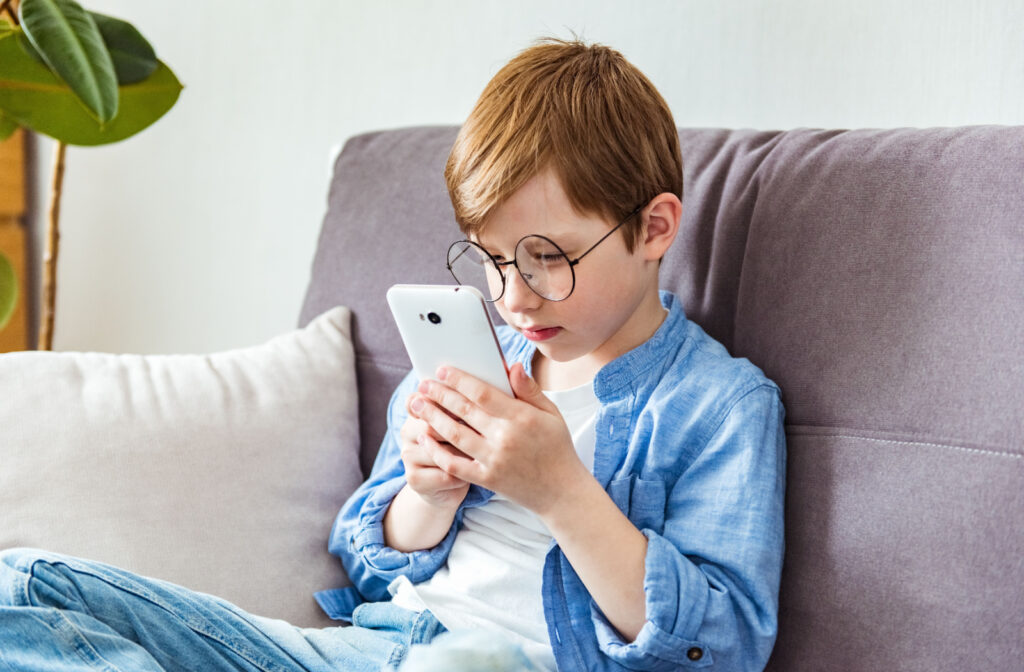Nearsightedness, more clinically known as myopia, is extremely common, and it affects millions of children worldwide. And for parents who already have myopia, it’s much more likely for a child to develop the same condition. Fortunately, our team at Fontana Optometric Group has a list of ways you can help slow your kid’s myopia progression!
5 tips for slowing myopia progression in kids include:
- Building good habits
- Spending time outside
- Using atropine eye drops
- Specialty contact lenses
- Regularly visiting the optometrist
What Is Myopia Anyway?
When your eyes are healthy and working properly, they bend, or refract, light. It reaches the retina, where it builds an image and sends it up to the brain. It’s an in-depth system that works great!
But what if the eye isn’t shaped right? What if it grows too long, or the clear lens at the front isn’t shaped right? Well, that’s myopia—or nearsightedness.
It usually develops during childhood, around the age of 6 or so, and keeps progressing until early adulthood. While your child grows, their eyes change too, so this condition often gets worse. It’ll often cause:
- Frequent squinting to see distant objects
- Difficulty reading or seeing the whiteboard at school
- Eye strain or headaches after prolonged near work
- Sitting too close to the TV or holding books close to the face
And since myopia is a progressive condition, it becomes important to try and control it. But how?
1: Build Good Habits
The first place to start is by building good habits. Your child is going to have this condition for a long time, so it helps to learn to build good habits to minimize how it’ll affect them.
Start with screen time. It’s a digital world in today’s day and age, so it helps to start with building a healthy relationship with screens and devices. Encourage your child to:
- Take regular breaks
- Control their screen time
- Make sure their environment is optimized. You don’t want things too bright or too dim—it makes their eyes work harder!
It can help to recommend they follow the 20-20-20 rule. Every 20 minutes, they should take a 20-second break and look at something 20 feet away. This helps their eyes adjust and keeps the eye muscles strong.
And if your kid already wears glasses or contacts, make sure they’re regularly wearing, cleaning, and storing them properly! Building these habits early on sets a strong foundation for better eye health in the future.
2: Spend Time Outside
Spending time outdoors isn’t just a great way to stay physically active and healthy. It actually can have a positive effect on your child’s eyes.
Children who spend more time in natural light typically experience less serious myopia progression. While this isn’t fully understood, the eyes of children who spend roughly 2 hours a day or more outside tend to elongate slower.
So encourage your child to regularly engage in outdoor activities! Go for a walk, enjoy nature, or throw a ball around for a while. It isn’t just about their vision either; it’s a great way to bond and take a break from all those digital devices!
3: Atropine Eye Drops
Atropine eye drops have long been used in medicine. And they’re a great way to slow myopia progression! When it’s administered properly, small concentrations of atropine help to temporarily relax the focusing mechanism in the eye.
However, there’s an important thing to note: on their own, they don’t do much. But when used with other types of myopia control, atropine eye drops can help! It’s important to talk to your optometrist to determine if this can help your child—they’ll be able to give you some guidance and show you how to use them.
4: Specialty Contact Lenses
When it comes to myopia control, one of the most effective approaches is through the use of specialty contact lenses. Here’s where things can seem a little complicated at first; there are a lot of options!
Orthokeratology
First up is orthokeratology, or ortho-k. With this approach, your child wears specialty lenses overnight while they sleep. These specialty lenses put gentle amounts of pressure on the edge of the eye and temporarily reshape it. Remember how myopia develops when the eye is misshapen—ortho-k lenses correct this shape. Then, once the lenses are removed, your kid has clear vision throughout the day!
Multifocal Lenses
Multifocal lenses are another extremely effective tool for myopia control. Just like regular contacts, your kid wears these throughout the day. But these lenses have a twist.
They’re designed with different prescription powers in different parts of the lenses. Some are for near vision, some are for far, and some are for that middle ground.
The unique design helps reduce how hard the eye has to work to switch between distances. However, it’s important to talk to your optometrist first before making any decisions—they’ll work with you and your child to help find the right pair of lenses for you.
5: Regularly Visit Your Optometrist
At the end of the day, the most valuable tool for myopia control is to work closely with your optometrist. It helps to find a team experienced with myopia control—like our team here at Fontana Optometric Group, Optometric Group of Upland, Optometric Group of Rancho Cucamonga, Optometric Group of Upland Downtown. We can check your child’s eyes and help determine an approach for reducing their myopia progression. So, why not book an appointment with us at Fontana Optometric Group and let’s help your child—together!


